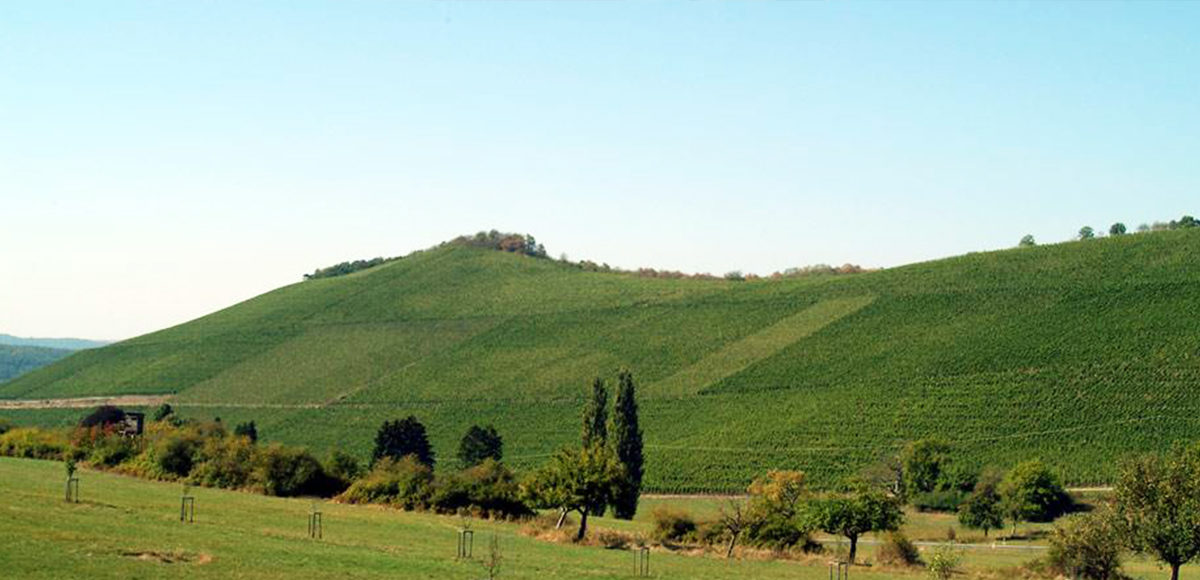Konz could be seen as a quaint, sleepy valley village in the Saar, surrounded by rolling vineyard hills, pastures and small houses with one modest church steeple–though it is anything but old-fashioned when Max von Kunow is around. Since assuming the estate in 2010, Max has nearly doubled von Hövel’s vineyard holdings, converted the estate to organic practices (including an intensive compost program) and he is in the process of transforming not only the viticulture, but also the style of the wines. Max’s father, Eberhard, preferred swift pressing of the grapes; Max is now working with some skin maceration, especially for the drier range, and a slower, gentler crush for the fruity range. In fact, a dry range really did not exist at this estate until Max arrived because his father did not prefer them. The wines destined to be fruity are less opulent than in vintages past; they are more crystalline and crunchy. In keeping with the organics practiced in the vineyards and the longer hang time prior to harvest, Max encourages indigenous yeast fermentations for all of his wines.
That’s a lot of change for such an iconic Saar estate in a short period of time, but Max is like a Tasmanian devil, wanting everything to evolve as quickly as possible. He seems up to the challenge! “Saar wines could be the best riesling on planet earth,” Max will tell you directly without any hint of irony or sarcasm. He is serious and he’s also a schatzi.
The 21-hectare von Hövel estate operates out of a manor house that was completed in the 12th century, where it initially served as an abbey retreat for the famous wine monastery of St. Maximin in Trier. Located in Konz-Oberemmel in a side valley of the Saar, which is known as Konzer Tälchen (“little valley” of Konz), the old cellar is today as it was over 800 years ago. The winery was inducted into what is now the von Kunow family in 1806 when it was purchased by Emmerich Grach—son of a well-to-do chandler and the great-great grandfather to Max von Kunow—the estate’s current proprietor. Grach was an assistant and deputy mayor of Trier, an influential businessman, and a well-known Weingutsbesitzer, or wine estate owner. In 1803 he purchased Maximinerhof in Oberemmel and renamed it Weingut Grach, alongside several other well-known estates in the region after Napoleon secularized the vineyards of the Saar and Mosel from the churches and monasteries. Grach’s son Johann Georg became owner of Maximinerhofgut, which later went to his grandson-in-law Forstmeister Balduin von Hövel, a head forester from Prussia and good friend of Kaiser Wilhelm II.
Von Hövel’s great-grandson is Eberhard von Kunow, whose parents bought the estate in the 1950s, at which point the winery began operating under the von Hövel family name. Eberhard von Kunow, Max’s father, owned and operated the von Hövel estate from 1973 until 2010 when Max (the 7th generation) took over the estate with an impressive debut vintage. While Eberhard produced fruity-styled Prädikat wines, Max slowly began to increase the dry range of riesling in hope to round out a classic Saar portfolio; he seeks to produce gastronomy-driven wines.
After finishing secondary school in 1997, Max took an apprenticeship with Kruger-Rumpf in the Nahe region where he decided to follow in his family’s footsteps and pursue a career in winemaking. The following year he worked for Lucashof in Forst (Pfalz), spent time working in Burgundy and returned to Germany where he interned at the Salway estate in Baden; Max completed four apprenticeships before beginning his winemaking studies in 2002. For two years he studied oenology in Veitschöchheim and afterward went on to pursue an International Wine Business degree at Geisenheim. During his time at Geisenheim, Max worked for his family’s estate as well as for Karthäuserhof and Fürst Löwenstein. He graduated from Geisenheim in 2007 where he worked as an export manager for the Wirsching estate in Iphofen (Franken) and in 2008, moved to Luxembourg where he consulted for 34 private winemakers. He returned to the family estate in 2010, when his father suffered an unfortunate stroke, jumped right in and as it turned out, achieved great success with his inaugural vintage; he was recognized by Gault-Millau as producing one of the top three Kabinetts (Oberemmeler Hütte) and the top Feinherb Riesling from the Scharzhofberg, both from the 2010 vintage. He took ownership of the estate the following year and has since nearly doubled their holdings.
Farming organically was a necessary transition for Max and he has taken it seriously. In addition to completely eliminating the use of herbicides, he propagates regional plants and herbs, prepares his own compost and spreads local straw, marc and raw fertilizer throughout his vineyards. As is the goal of most mindful growers, Max lets the grapes hang as long as possible to ensure they reach—and in some cases exceed—physiological ripeness, or as Max refers to it, “mineral ripeness”; the Saar is the coolest and most windy region in Germany and often requires a longer hang-time than in warmer regions of the world. He avoids botrytis for the dry range but sometimes includes it for the Prädikat bottlings.
When the grapes enter the cellar, Max separates the fruit that he feels is destined for skin maceration (anywhere between 18-36 hours) from the rest in which undergoes gentle crushing before entering the press. Wines are fermented in either stainless steel tanks or neutral wooden 1000 liter Mosel fuder casks. All of the wines ferment spontaneously.
The von Hövel estate has ownership in the following vineyards, all of which are planted exclusively to riesling: Oberemmeler Hütte (5.8 ha), the famed Scharzhofberg (2.8 ha), Kanzemer Hörecker (0.6 ha), Oberemmeler Rosenberg + Rosenkamm, Krettnach Silberberg and Niedermenniger Euchariusberg. Hütte, Herrenberg and Hörecker are all monopoles of the estate.























